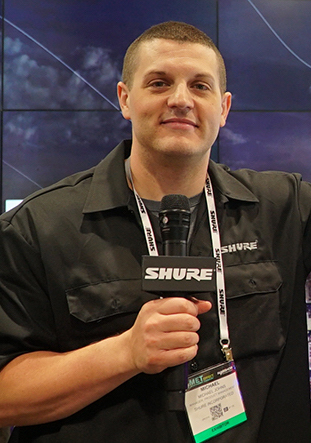Tech Focus: Bodypacks, Part 1 — Increased Demand for Onfield Audio Boosts Wireless Transmitters
Enhanced functions help products stand out in a crowded market
Story Highlights
Bodypack transmitters have endured significant environmental shifts over the past decade. Besides two rounds of critical spectrum reductions, they’ve experienced the shift from largely analog to increasingly digital formats, driven in part by the spectral changes and by sports television’s demand for enhanced encryption capability. All the while, brands looked for ways to differentiate products in a niche but crowded market, adding functions like audio recording, remote control, and battery-status monitoring.

Sennheiser’s Greg Simon: ‘Once you can reliably eliminate [intermodulation], you can place transmitters and receivers almost anywhere.”
“A focus has been to eliminate intermodulation as much as possible,” he says. He refers to an artifact that generally occurs when two or more transmitters close to the receiving antenna produce very strong and simultaneous signals in the receiver, creating what are known as “phantom” frequencies. “Once you can reliably eliminate that, you can place transmitters and receivers almost anywhere. That expands the ability to use wireless and with much more efficient use of spectrum.”
Simon adds that Sennheiser’s sale of its consumer-electronics division, in May 2021, lets the company focus even more intensely on the pro-audio sector. In recent months, that has included development of new custom switches for wireless bodypacks, the type often used by on-field officials, to manage the transmitters’ use during games. At least one major league is evaluating that kind of switch on Sennheiser’s 6000 series bodypacks.
"Well depending on how hard it's hit. If it's hit hard he's probably not gonna go home. … Here it is!"
This mic'd up moment with Kiké Hernandez was awesome 👏 pic.twitter.com/M1osm0BDgD
— ESPN (@espn) April 11, 2022
Talking on the Field
Sports leagues themselves have increasingly become consumers of wireless audio in recent years, as they beef up social-media content and broadcasters seek more on-field and on-player audio, such as live, in-game conversations between MLB outfielders and on-air announcers. That trend has driven a steady expansion of the product lines at Q5X, the Canadian company specializing in wireless bodypack transmitters designed to absorb the shocks of high-impact sports — the NBA and NHL players and officials are large users of its PlayerMics and RefMics — and avoid hurting wearers with the use of flexible and impact-absorptive form factors and materials.

Q5X’s Paul Johnson: “There are more microphones than ever, on athletes and referees, and it’s spreading from the major leagues to newer sports, like the XFL and USFL.”
“The technology of the wireless bodypack transmitter has reached a high degree of development, in terms of functionality and the ability to navigate a new spectrum landscape,” says Q5X CEO Paul Johnson. “What’s changing in the sector is the expansion of its use. There are more microphones than ever, on athletes and referees, and it’s spreading from the major leagues to newer sports, like the XFL and USFL.”
Miking players, coaches, and officials has increased almost exponentially, from usually one player per side to, in the case of the USFL last year, every player on every team — 16 player microphones per team, 32 per game — plus coaches and officials. League all-star games are also putting microphones on more participants. Q5X, which leads this aspect of the sector and has developed versions of its transmitters for water and snow sports and golf, has sold products to the rental and wireless-management houses that support the broadcast-sports networks, including Bexel, BSI, PWS, and CP Communications.
“It’s being driven by fans who want to get closer to the action and the athletes and by the broadcasters who want to give that to them and increasingly deliver that audio live during the game,” says Johnson. “[Wireless transmitters] are still a very niche segment of the broadcast-audio market, but it’s an exploding one.”
Need To Diversify Drives Collaboration
Like other maturing tech-market sectors, wireless transmitters have experienced changes at the business level. In 2021, for instance, Shure and Q5X began collaborating on new wireless transmitters that combine Q5X’s hyper-compact form factors and safety-conscious industrial design with Shure’s widely used Axient Digital RF technology. Axient’s digital operation allows versions of Q5X’s primary models — CoachMic, PlayerMic, AquaMic — to function as digital devices, adding signal encryption and improved spectral efficiency to Q5X’s diminutive form factors. The new product, the Q5X QT-AD10 Axient digital wireless transmitter, is sold through each company’s distribution channels.

Shure’s Michael Johns sees “increasing demand for wireless-channel counts, with end-zone interviews, sideline reporters, field audio — you name it.”
The venture has gone well for both parties, according to Michael Johns, associate director, wireless systems global product management, Shure. He notes that, five years ago, Shure had recently developed its own digital platform, Axient Digital, and Q5X had been diversifying its product types to conform to the needs of different sports.
“[Q5X’s analog] platform was compatible with the receivers of a number of third-party manufacturers,” he says, “but, to move to digital, they would have had to develop their own proprietary digital intermodulation scheme and codec. We had that ready to go.”
That kind of synergy is timely, Johns adds, as the demand for wireless channel counts increase. Teams and venues are joining leagues in looking to audio as they pursue new original content for social media and other outlets.
“The broadcasters and the leagues have been driving that for some time, but now the teams and venues are doing it, too,” Johns says, noting the Chicago Bears’ own YouTube channel. “That’s increasing demand for wireless-channel counts, with end-zone interviews, sideline reporters, field audio — you name it.”
Ever Smaller and Lighter
Although many of the technical challenges with wireless bodypacks have been accommodated over the past few years, refinements continue, says Lectrosonics VP, Sales, Karl Winkler. “There’s increased emphasis on small and tough units, as well as on features like variable power settings and a wide tuning range.”
The proliferation of sideline audio-collection technicians has stimulated demand for smaller, lighter “bag systems,” products that enhance the mobility of live-sound–gathering during games. According to Winkler, the totes filled with the receivers and other electronics that A2s lug around the perimeters of playing fields can reach 10-20 lb. — a significant weight over the course of hours of a game or match.
“Now we can get that bag down to 3 or 4 lb. and still get eight channels in there,” he says. “The wireless bodypack receiver has come a long way, but there are still things about them that are getting better.”
Click here for Tech Focus: Bodypacks, Part 2 — Transmitters Offer a Wide Variety of Features.

